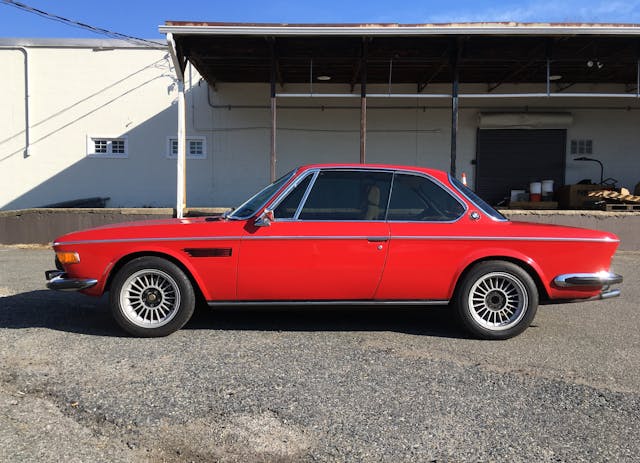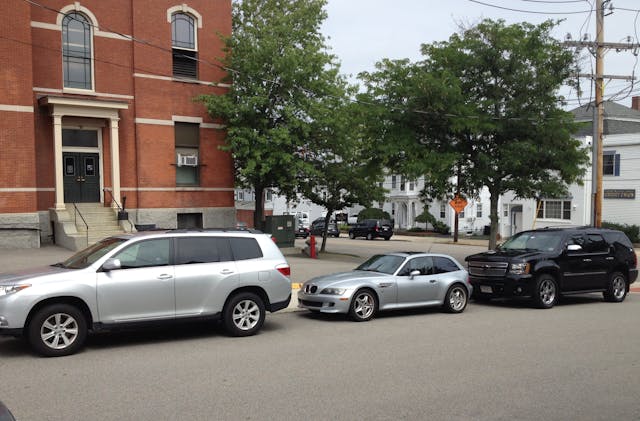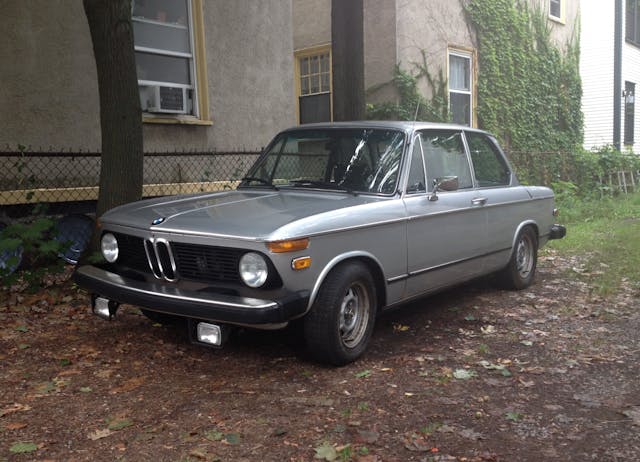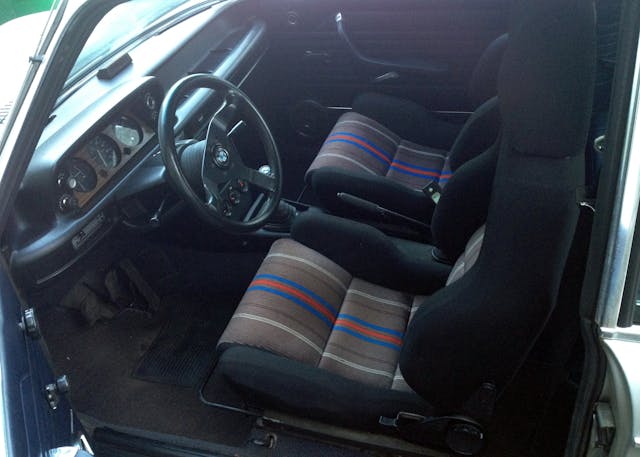Daily driving a classic can be a lot of fun, but should you?

I write a lot about the joys and pains of owning vintage cars. Much of my content revolves around a) doing preventive maintenance so you can live the dream and road-trip the cars, and b) putting the cars away for the winter and pulling them out in the spring.
But there is another way to use a vintage car.
Daily drive it.
Wait, what?
Before you start lobbing tomatoes at me, let me be clear about two things. First, I believe that while it is your car and you are free to do anything you want with it, there are certain bounds of propriety that you should accept if you want to be a responsible member of the vintage car world and not look like a spoiled brat with a trust fund. If you live in a location, like my beloved state of Massachusetts, where at the first snowflake they lay down so much salt that you can hear the bridge decks rusting, it is jarring to even think of someone taking a rust-prone classic like a Jaguar XKE or a vintage 911 and doing donuts in the parking lot with it. And it’s downright heartbreaking to hear of someone daily driving such a car in salty slush.
There are limits, and when exceeded they get you reported to the oft-whispered-about Society for the Prevention of Cruelty to Vintage Cars (SFTPOCTVC). They have British Racing Green helicopters. You don’t want to know what the penalties are.
Second, if you insure your car with a specialty insurance provider, there are restrictions on your policy that essentially require that you don’t daily drive it—for instance, Hagerty requires that all household members with a valid driver’s license have a regular-use vehicle for daily driving and maintain regular-use insurance in their own names. The idea is that if you own and insure a daily driver, you’re likely to also drive it, which means you’re not driving your classic every day. (If you have any questions about what your policy entails, call your provider and speak with a representative.)
But let’s assume for the moment that there are no insurance limitations or weather concerns. You love your car, and driving it gives you great pleasure. Why wouldn’t you daily it if you could?
Or maybe I should phrase it in a less value-loaded way: Would you daily-drive your collector car if you could?

Let me start with a story. About 15 years ago, I had a 1973 BMW 2002tii (similar to the one that I sold for my friend Mike on Bring a Trailer) that I’d just finished sorting out. I had it on eBay, and a local fellow came to check it out. He said he’d craved one of these cars for decades. He looked at it, drove it, loved it, and literally pulled out a checkbook and began writing me a check for my asking price.
“Where do you live?” I asked.
“Beacon Hill” (a classic old downtown Boston neighborhood).
“Boy,” I said, “renting garage space down there must be pricey.”
“I don’t have a garage.”
“So where would you park it?”
“On the street.” I was stunned.
“You don’t even have off-street parking for your other car?”
“This would be my only car.”
“We need to talk.”
I explained that if he took an old rust-prone car like this with its small ornamental bracelet-like bumpers and parked it on the street in downtown Boston, in nine months it would be unrecognizable due to bumper bashes, weather, and likely vandalism, and that the best thing I could do was not take his money and force him to think about what he was proposing.
He wasn’t happy. The guy was a surgeon and was not used to being talked to like this. He yelled at me, saying, “Who the hell do you think you are not to take my money?” I calmly held my ground.
In the morning, he called me. To my surprise, he thanked me for forcing him to think things through. He realized that he wasn’t only looking to buy a vintage car—he needed to buy a support structure for a vintage car.
Now, OK. That’s an extreme case. You’re not like that. You’re likely Hagerty client who already owns a vintage, or classic, or valuable car and understands about the larger support structure and the myriad of issues of caring for the car.
So, given that, would you daily drive the car if you could? Do you even want to?
It’s an interesting question, n’est pas?
I first insured a car with Hagerty nearly 20 years ago. It was the 1973 BMW 3.0CSi that I’ve owned since 1986. Since it has a Karmann-built body, and since the essential must-know automotive joke is that Karmann invented rust, then licensed the process to the Italians, it goes without saying that the car never sees snow or salted roads, as you can hear it scream like the demons in Constantine when holy water is mixed in with the sprinkler system. But for decades, whenever the weather was amenable, I commuted to work in the car the five miles each way on local roads. Stopping myself from doing so when the car went on the Hagerty policy took some adjustment, but it was the right thing to do. The policy for the guaranteed value of $14,000 cost me something like $120/year, which was about 1/5 of what I was paying for conventional insurance. Obviously, both the guaranteed value and the premium have increased since then.

Not entirely coincidentally, around this time, I bought my 1982 Porsche 911SC. Knocking down the premium on the 3.0CSi by putting it on the Hagerty policy was one of the things that enabled the purchase of the Porsche. I daily-drove the bejesus out of it, which certainly took the sting out of the restricted use of the 3.0CSi. At the time, Massachusetts had insurance laws that allowed a Hagerty-type policy only on cars that were at least 25 years old, so the SC remained insured conventionally for years.

History rapidly repeated itself when, in 2007, I happened into a decently priced 1999 BMW M Coupe (a.k.a. “the clownshoe”). The 911SC had just turned 25 years old and thus qualified to go on the Hagerty policy. It and the 3.0CSi officially became weekend cars, and the M Coupe became the fun daily driver. At some point, Massachusetts insurance rules changed, allowing me to put the M Coupe on the Hagerty policy as well.

I mention these three cars to make the point that I had been daily driving them before I elected to take the trade-off of increased coverage (and, in my case, lower premiums) for restricted use.
Now, in truth … yeah. You got me. I wasn’t really daily driving these cars, in the sense that they were my only car. I always (well, almost always, and we’ll get to that) had a dedicated daily. Even during non-winter seasons, I take pains to keep the rust-prone cars out of the rain, and obviously they’re only brought out in the winter if there’s a long-enough snowless stretch and a good-enough hard rain to wash the salt off and ensure that a winter drive isn’t utter SFTPOCTVC-taunting folly.
Taking a step back, let me pose a counterpoint to my own question. There are certainly very good reasons why you might not want to daily drive your classic even if there weren’t insurance or rust issues. It might be not wanting to put miles on a low-reading odometer. Or you might be concerned about scratching the beautiful paint or dinging the restored body. Or, if you have a decently long highway commute, the reliability issues of an old car might be a primary concern, or the wind noise from the old door seals might be fatiguing. Or the car’s climate control system might be inadequate for your location’s heat and cold. Or you might have been caught in the rain in the car once and found how stress-inducing vintage cars can be in even short heavy downpours, with their uneven braking and wipers running at the speed of a 90-year-old man picking up his mail. Or it might be as simple and understandable as liking pecan pie for Thanksgiving desert but not wanting to eat it every morning and evening. Or enjoying a short visit with your aunt Minnie but not wanting her to move in with you. Nothing wrong with any of that.
I daily drove BMW 2002s from 1982 through ’88, then moved onto whatever needy affordable BMW 3 or 5 Series sedan I could find. From 2008 through ’16, I drove BMW wagons—first an E39 1999 528iT that broke all the time, then a more-robust 2001 E46 325XiT. When the 325 wagon was beginning to get needy, and a friend of mine offered to buy it, I took him up on it. I certainly had other cars to drive—in addition to the Hagerty cars, I had a ratty 2000 Suburban that came on and off the road depending on whether I needed to use it, and my Z3 roadster wasn’t yet on my Hagerty policy—but I unexpectedly found myself without a dedicated daily driver.
Then I stumbled onto a ’74 2002tii for a good price. Suddenly I had the chance to wind the clock back to the 1980s and daily-drive a BMW 2002 again. The guy who’d owned it for 30 years drove it to one of the lawn events at the Larz Anderson Auto Museum in Brookline, Massachusetts, with a “For Sale” sign on it. After chatting with him for a bit, he asked my advice on how to price the car. A few days later I went to his house and examined it thoroughly. Both of the rear shock towers had rust that was concerning but not unsafe, the exterior had a few rust blisters, and the car immediately needed a few minor repairs, but in general it looked good and drove well.

I said something like, “In better condition, it would be worth $Z. If you did this and that to it, it would be worth $Y. But to someone like me, as-is, it’s worth closer to $X.”
“I’m not afraid of $X,” he said.
“Just to be clear,” I said, “I’m not offering you $X.”
I paused.
“But if I WERE offering you $X …”
After a brief negotiation, I wound up with the car, which came with the name “Otto.” After I fixed a few things, I found that, to my surprise, it was one of the most solid-feeling, low-thunk, low-rattle 2002s I’d ever owned.
At the time, I had another 2002, a rust-free, small-bumpered, round-taillight ’72 2002tii that was easily worth four times what I’d paid for Otto. The chrome-bumpered cars are much trimmer and prettier than the ’74 and later cars with the big federally mandated 5-mph bumpers, which on a 2002 have all the delicacy of a tugboat. However, the small bumpers will crumple instantly if they’re nudged, whereas the big bumpers generally will withstand not only parking bumper-to-bumper taps, but also people texting at red lights and rolling into you.


I’d recently left my 30-year engineering job and began working full-time at Bentley Publishers in Cambridge. It was slightly farther from my house, maybe eight miles each way instead of five, but still an easy commute along local roads. Something about the combination of having just become a full-time automotive writer, selling the wagon, and buying this unexpected big-bumpered driver-quality 2002tii made me think … DAILY DRIVER!
So, instead of adding Otto to my Hagerty policy, I treated myself and put the car on my regular policy and began daily-driving it to work. To increase my comfort, I transferred the pair of Konig (Recaro-style) seats from my other 2002 into the car.

I had an absolutely delightful four months with Otto. I drove it into Cambridge nearly every day. I didn’t scan the rear-view mirror in terror while sitting at stop lights as I do in the small-bumpered cars (and yes, people rolled into Otto’s bumpers twice). If I had somewhere to go after work, I simply drove the car and parked it, whether that was in a lot or on the street. And, since I had the car conventionally insured, I didn’t need to worry about violating my Hagerty policy. It was liberating.
And, while I don’t own or drive these cars to have people look at me, I have to admit that, from a self-image standpoint, it was kind of cool to be the guy choosing to daily drive a BMW 2002 30 years after that fat part of the curve of the car’s usage profile had passed.

When the snow began to fall, I did pull Otto off the road for the winter (I’m not a Philistine) and daily drove the ratty Suburban for one final season before selling it. That winter, I happened into the 2003 530i stick sport that I still have, the car that’s proven to be the best daily driver I’ve ever owned.
When I prepared Otto for sale the following spring, I performed a routine compression test and found that the car had low compression in one cylinder. A leak-down test revealed that the head was cracked. I knew that Otto’s sale value was going to be capped by the rusty rear shock towers, so pulling off the cracked head, sourcing another head, getting the valve job done, transferring the components, and reassembling the engine ate up any profit I might have had in the car. But I didn’t regret any of it for a moment.
So, should you daily drive your vintage car? Obviously, you need to take into account the value of the car, its fragility, the climate, where you work, and other real-world factors. If you’re serious about it, and the parameters are such that the SFTPOCTVC won’t bust you, and you work out the insurance issues, you might want to give it a test drive before a full-on commitment. Sort of like having pie for breakfast every day for Thanksgiving weekend. Or a week with your aunt Minnie.
Just don’t tell me you’re doing it on Beacon Hill, or I’ll give you the what-for.
***
Rob Siegel’s latest book, The Best of the Hack MechanicTM: 35 years of hacks, kluges, and assorted automotive mayhem, is available on Amazon. His other seven books are available here, or you can order personally inscribed copies through his website, www.robsiegel.com.


Great topic, I share your perspective on road salt, and love your appropriate use of related imagery. It is truly evil incarnate and I can’t believe we still have not found a decently priced alternative that does not have such negative effects. So, if you enjoy a classic, as long as the use remains salt free and if it’s reasonably practical based on the required use i.e. type of traffic and distance, and you’re not fussed on where it will be parked, I would encourage using it as such. In my view it keeps it sorted and useful. Personally, as my dailies, I use a 38 year old beater during the salty season and a 19 year old youngin for the rest of the year. My 40+ year old classic is for cruising.
I’ve daily driven vintage cars continuously for nearly 30 years. Daily driven all the way: my only car on full insurance. I started with an Edsel (well, three successive Edsels…) in the early 1990’s, followed by a Rambler, a ’66 VW Bug, early 60’s Dodge Dart and more recently vintage Mercedes (starting with a w123 diesel then regressing to earlier w108s and 109s). Winters here in Oregon mean it’s more important for the cars to be water-tight, rather than worrying about snow. Meaning I can drive them year-round.
A few lessons learned: My daily commute is about 10 miles each way, which is manageable in terms of wear and tear on the car. There’s a sweet spot between a car being too old and “antique” (the Edsels were fine in the 1990s but not suitable now) and too new (the 1980s-vintage Mercedes was too modern for my tastes… not “old enough”). The air suspension and V-8 engine on my last daily driver, a 1972 Mercedes 300SEL, were so complex, expensive and hard to work on myself that I ditched it after about a year (but it was a glorious year!). Next came my current 1967 280SE, a just-right ‘Goldilocks’ of a car: six cylinder, 4-speed manual, good gas mileage and sport sedan handling that is a joy to drive. Best of all, none of the touch screens, cup holders or driver assists of a modern car.
Maybe these reflections will help others decide to drive an old car every day. Rarely if ever have I been stranded on the road, and the cars have been cheap to maintain and super fun to drive!
So, so true..
We have two newer Benzes. I keep looking at W123/W124s. My wife wants a new GLS.
I want less between me and driving; the old MB-Tex Battleship Benzes that were built for a half a million miles (Unlike the shoddy build of the new ones), she wants wall to wall screens.
I’m not sure I see myself buying a new Benz, I’m just not impressed. They drive fine, but feel cheap; and I’ve been driving them since my 20s (I’m 46.) I aim to find something older, with K-Jetronic and A/C and just drive the thing.
Back in the 1980’s through about 2007, I used to daily drive old cars during the warmer months in Upstate New York. I would drive old cars to work from April until the first snow in November or December. My work commute was almost 50 miles a day over country roads.
But old cars from the ’60’s require more work to keep running. So, I owned two of them. I ran one and spent the summer rebuilding the other for next year. I dropped transmissions about once every few years and engines needed to be pulled about every seven to ten years. I spent a lot of time in my shop to keep them running. My wife didn’t really like that. So if you plan to daily drive an old car, it helps to have shop space and a big tool box.
I believe you can, personally i would love to daily drive my ’57 Ford Fairlane 500 Sedan if it werent for the lack of exhaust on the car. people did it back then, why cant they do it now?
other than winters, they always get parked in winter.
I can easily understand your attraction to using an old classic as a daily driver. I use a 1973.5 911T as my primary vehicle. I live in southern California, so rust is not much of an issue. I’ve had this car for almost 20 years. It runs well and, for a car of that vintage, has been pretty reliable. Some years ago I added a front auxiliary oil cooler and rebuilt the air conditioner so that it works well, even in temperatures of 110 degrees or so, which is necessary if the car is to be useful year round. We’ve taken it on road trips and vacations as well as on the usual local errands, and it’s done well.
These cars were originally made with components that were generally of very high quality, and I think that some parts, such as the CD ignition system, are still original. Unfortunately, the replacement parts that are available are often not of the same quality, and so if something fails, it’s at least as likely to be a relatively new replacement part as one of the original components. I’ve found that it’s best, whenever possible, to have old parts overhauled or rebuilt rather than buy new ones. I’ve been driving these early 911s for 50 years now so I’m reasonably familiar with them. My backup car is my wife’s 2014 991, but I rarely need to use it.
As you have observed, aside from the pleasure of driving such a neat old car, one of the enjoyable parts is the attention it gets and the offers to buy it which come at random, even shouted out from cars going the other direction on the street. I have no plans to replace it with anything else.
Since you work for Bentley, let me put in a request for a service manual for early 911s, say 1969 – 1973. Last I checked, that was a gap in your product line.
Dave, my employee relationship with Bentley Publishers ended in the fall of 2016. I am still on good terms with them, but I have zero pull in terms of recommending new titles.
A good friend daily-drove a ’64 Thunderbird through college in the mid/late 90s. It wasn’t a perfect car, by any means.
She was heavy, had posi, a great heater, was comfy, got abysmal gas mileage (a 390 with the Motorcraft/Holley 4V), and served him well.
Winters in Oswego, NY (where he went to school) didn’t treat it well. She didn’t seal, so there was often frost *inside* the car windows, and the swing-out steering column would get fiddly making contact to start when it got cold. But, it always got him home, and never failed to start in any temp.
Not sure it would be my choice. I’d aim for an older Subaru or Audi (if I had the patience for VW/Audi/Porsche electrical goblins) for the AWD benefits, and the disposability factor.
My toys sit in a heated garage for the winter. I’ll thrash on the W212 Estate for another few years before I seek it’s replacement.
I know Hagerty well as I’ve been a great race participant since 2013 and think highly of them. That being said, State Farm was cheaper for my Chevy II. As for driving a classic, I truly believe that we’re the last generation that will truly appreciate them. Fewer and fewer kids are driving these days and fewer still appreciate our old cars. I registered mine as a regular car with no historic restrictions and drive it as such. Build it ,drive it, rally it and race it. It will do you no good when you’re gone. If the youngsters now are interested, let them build their own. They’ll appreciate it that much more.